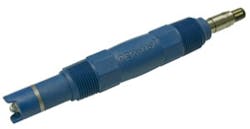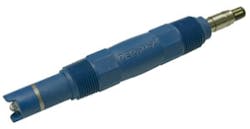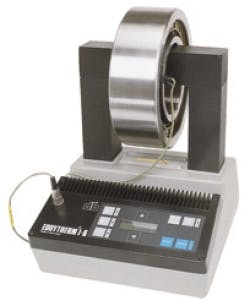Applications for Ceramic Gas Diffusers
By Steve Deiters
Porous stone diffusers have been used to disperse high volumes of fine bubbles in very dense gas patterns in a wide variety of applications for literally hundreds of years. Applications range from oxygen transfer in wastewater treatment plants, to disinfection of potable water with ozone, stripping of volatile organic compounds in manufacturing processes and groundwater remediation sites, and many others.
Ceramic fine bubble diffusers come in a variety of shapes and sizes ranging from domes and discs that operate in a vertical format to tubular or rod styles designed for use in a horizontal format. Materials of construction for ceramic diffusers range from the original porous slag to silica and the high performance fused aluminum oxide materials of today. The evolution of ceramic diffusers has been driven by the need for consistent operation and higher degrees of compatibility with a wide variety of hostile operating environments.
Typical ceramic tubular diffuser and ceramic dome fine bubble diffusers of varying porosities for industrial applications.
The most widely found use for ceramic diffusers is in biological treatment applications that require high mass transfer rates of oxygen interfacing with liquid, such as wastewater treatment. They are also used for the disinfection of potable water with ozone gas. Such systems have been in use in Europe for quite some time but have been slow to evolve in the United States. That is partially due to the slow acceptance of new technology in the U.S. and the expense of replacing existing infrastructure.
Ceramic dome diffusers installed on a conversion header in an existing system originally designed for horizontal format diffusers. From previous operation a reddish patina formed on the header pipes from mineral content in water source.
Non-Traditional Applications
As with all devices and hardware used in process technologies, improvements in the technology set the stage for alternative application that before had no easy solutions. One problem solved with ceramic fine bubble diffusers is the treatment of groundwater contaminated with volatile organic hydrocarbons. VOCs can originate from a variety of sources ranging from gas stations with deteriorating underground fuel tanks to industrial or military sites where hydrocarbons, solvents, and other contaminants have percolated down and found their way into the water table.
The more traditional approach for groundwater remediation involves pumping the groundwater from the contaminated plume into a tank for treatment. Once the VOCs have been volatilized and removed, the water is pumped back into the ground in a closed loop basis. This approach tends to be capital and manpower intensive, but the simplicity of design makes it desirable for many applications.
An approach gaining increasing acceptance in recent years is the instu treatment of groundwater contaminated with hydrocarbons. This is achieved by identifying the extent of the contaminated groundwater plume by sinking wells and testing the groundwater. Once the size and extent of the plume is established the well casings can be used in the treatment process.
Ceramic tubular diffusers are horizontal format devices by design and typically are installed parallel to the bottom of a vessel. For insitu groundwater applications the tubular diffusers are rotated and used as a lance that is inserted into a well casing. The exterior of the diffusers are then packed with media and sealed using application specific packing materials to maximize the efficiency of the process. The diffuser is connected to the gas source such as air, oxygen, ozone or others as required for a successful remediation process.
The function of the system is based on the natural movement and flow of the groundwater water coming in contact with the active area of the gas diffuser. The media provide an added benefit by slowing the rise rate of the bubbles in this type of installation. The number of wells required is driven by the severity of the remediation requirement, size of the contaminated plume, and the extent that it has travelled.
Ceramic diffusers can also be used for pH adjustment in wastewater treatment applications. This is accomplished by using commercially available sources of carbon dioxide and interfacing the gas with the flow in a trough or a tank.
Ceramic fine bubble diffusers can create a large volume of bubbles for interfacing with resultant surface area interfacing with liquids to perform a variety of tasks
Some installations with a need for pH adjustment may also have access to flue gas, an acidic by-product of combustion in manufacturing or facility heating processes. A side stream of flue gas can be pumped to the diffusers and works in conjunction with solenoids or actuated ball valves and a pH controller to achieve the targeted level of pH adjustment prior to discharge. In those cases, handling of dangerous chemicals and their ongoing cost is eliminated and a previously wasted by-product of operation is put to use in what could be considered a “green” application.
Fine bubble diffusers have also been used for boosting levels of dissolved oxygen in wastewater or process streams prior to discharge to municipal systems or streams. The final dissolved oxygen level is typically driven by prevailing local, regional, or national enforcement guidelines.
Retrofits
Ceramic diffusers can offer a viable hardware alternative when upgrading systems. Many older installations often had tubular or rod style diffusers which were the diffuser of choice for many years. The major stumbling block to system upgrades is the need to reformat the piping manifold and headers from a system that was designed for horizontal format diffusers (tubular style) to one that can accommodate vertical format (dome style) diffusers.
One solution to the problem uses the existing manifold and header system with tubular replacement header adaptors fabricated to accept multiple ceramic dome diffusers. The existing tubular diffuser is removed and the adaptor “header” is threaded into place with the vertical format connections located at the 12 o’clock position for final installation. The changeover can literally be accomplished in hours rather than weeks or months.
About the Author: Steve Deiters is president of Diffused Gas Technologies Inc. of Lebanon, Ohio. The company is a manufacturer of fine and coarse bubble air/gas diffusers and systems used in the water and wastewater treatment industries. He has held marketing, project management, and technical positions with pollution control equipment manufacturers such as Pollution Control Inc. and Clow Waste Treatment Division as well as capital equipment manufacturers serving the process and electronics industries.



